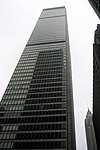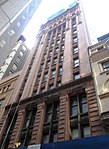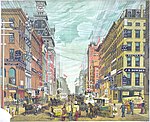Group of Four Trees (Jean Dubuffet)

Group of Four Trees is an abstract outdoor sculpture completed in 1972 by the French 20th-century artist Jean Dubuffet. Originally commissioned by the American banker and philanthropist David Rockefeller, the work measures 43 feet and is installed in the public plaza of 28 Liberty Street (formerly One Chase Manhattan Bank Plaza) between Nassau Street and Pine Street in Financial District, Manhattan.Dubuffet, a leading figure in the Art Brut movement, considered Group of Four Trees as part of his Hourloupe series. The series, originating from ballpoint pen doodles in 1962, features flat, interlocking shapes and striated coloring in red, white, and blue against black backgrounds. At the time of installation, Group of Four Trees was the largest outdoor sculpture in New York City and was said to have dramatized "the increasing environmental interdependence between architecture and outside sculpture" in the 1970s.
Excerpt from the Wikipedia article Group of Four Trees (Jean Dubuffet) (License: CC BY-SA 3.0, Authors, Images).Group of Four Trees (Jean Dubuffet)
Fosun Plaza, New York Manhattan
Geographical coordinates (GPS) Address External links Nearby Places Show on map
Geographical coordinates (GPS)
| Latitude | Longitude |
|---|---|
| N 40.7075 ° | E -74.008888888889 ° |
Address
Fosun Plaza
Fosun Plaza
New York, Manhattan
New York, United States
Open on Google Maps











